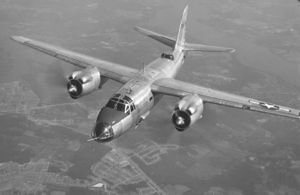B-26 Marauder
First flown in 1940, the B-26 Marauder was one of the two major U.S. Army Air Force medium bombers of the Second World War. It operated in all theaters, but principally in the Europe and Mediterranean. It commonly bombed from 10-15,000 feet, as opposed to the B-25 Mitchell, which was the predominant medium bomber in the Southwest Pacific and was known as a low-level aircraft.
While it was eventually to have an extremely low loss rate, the early versions were hard for inexperienced pilots to fly, sometimes called the "Widow-Maker". BG James Doolittle, who was to command a B-26 wing in North Africa after the Doolittle Raid, was given responsibility for solving the problem. Engineering improvements, as well as better training, solved the problem. Doolittle personally demonstrated that he could fly the aircraft even after shutting one of its two engines immediately after takeoff.
Typical specifications
- Span: 71 ft. 0 in.[1]
- Length: 56 ft. 1 in.
- Height: 20 ft. 4 in.
- Weight: 38,200 lbs. (maximum)
- Armament: 11 .50-cal. machine guns plus 5,200 lbs. of bombs (max overload)
- Engines: Two Pratt & Whitney R-2800-43 "Double Wasp" radials of 2,000 hp each (takeoff power)
- Crew: Seven
- Maximum speed: 283 mph at 5,000 ft.
- Cruising speed: 216 mph
- Range: 1,100 miles with 4,000 lbs. bomb load
- Service ceiling: 19,800 ft.
References
- ↑ U.S. Air Force fact sheet http://www.nationalmuseum.af.mil/factsheets/factsheet.asp?fsID=2524
